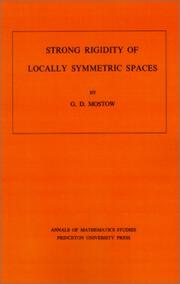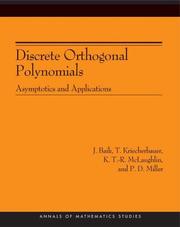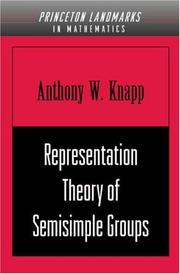| Listing 1 - 10 of 13 | << page >> |
Sort by
|
Book
Year: 2021 Publisher: Basel, Switzerland MDPI - Multidisciplinary Digital Publishing Institute
Abstract | Keywords | Export | Availability | Bookmark
 Loading...
Loading...Choose an application
- Reference Manager
- EndNote
- RefWorks (Direct export to RefWorks)
Mathematical models of various natural processes are described by differential equations, systems of partial differential equations and integral equations. In most cases, the exact solution to such problems cannot be determined; therefore, one has to use grid methods to calculate an approximate solution using high-performance computing systems. These methods include the finite element method, the finite difference method, the finite volume method and combined methods. In this Special Issue, we bring to your attention works on theoretical studies of grid methods for approximation, stability and convergence, as well as the results of numerical experiments confirming the effectiveness of the developed methods. Of particular interest are new methods for solving boundary value problems with singularities, the complex geometry of the domain boundary and nonlinear equations. A part of the articles is devoted to the analysis of numerical methods developed for calculating mathematical models in various fields of applied science and engineering applications. As a rule, the ideas of symmetry are present in the design schemes and make the process harmonious and efficient.
high-order methods --- Brinkman penalization --- discontinuous Galerkin methods --- embedded geometry --- high-order boundary --- IMEX Runge–Kutta methods --- boundary value problems with degeneration of the solution on entire boundary of the domain --- the method of finite elements --- special graded mesh --- multigrid methods --- Hermitian/skew-Hermitian splitting method --- skew-Hermitian triangular splitting method --- strongly non-Hermitian matrix --- lie symmetries --- invariantized difference scheme --- numerical solutions --- finite integration method --- shifted Chebyshev polynomial --- direct and inverse problems --- Volterra integro-differential equation --- Tikhonov regularization method --- quartic spline --- triangulation --- scattered data --- continuity --- surface reconstruction --- positivity-preserving --- interpolation --- jaw crusher --- symmetrical laser cladding path --- FEPG --- wear
Book
Year: 2021 Publisher: Basel, Switzerland MDPI - Multidisciplinary Digital Publishing Institute
Abstract | Keywords | Export | Availability | Bookmark
 Loading...
Loading...Choose an application
- Reference Manager
- EndNote
- RefWorks (Direct export to RefWorks)
Mathematical models of various natural processes are described by differential equations, systems of partial differential equations and integral equations. In most cases, the exact solution to such problems cannot be determined; therefore, one has to use grid methods to calculate an approximate solution using high-performance computing systems. These methods include the finite element method, the finite difference method, the finite volume method and combined methods. In this Special Issue, we bring to your attention works on theoretical studies of grid methods for approximation, stability and convergence, as well as the results of numerical experiments confirming the effectiveness of the developed methods. Of particular interest are new methods for solving boundary value problems with singularities, the complex geometry of the domain boundary and nonlinear equations. A part of the articles is devoted to the analysis of numerical methods developed for calculating mathematical models in various fields of applied science and engineering applications. As a rule, the ideas of symmetry are present in the design schemes and make the process harmonious and efficient.
Information technology industries --- high-order methods --- Brinkman penalization --- discontinuous Galerkin methods --- embedded geometry --- high-order boundary --- IMEX Runge–Kutta methods --- boundary value problems with degeneration of the solution on entire boundary of the domain --- the method of finite elements --- special graded mesh --- multigrid methods --- Hermitian/skew-Hermitian splitting method --- skew-Hermitian triangular splitting method --- strongly non-Hermitian matrix --- lie symmetries --- invariantized difference scheme --- numerical solutions --- finite integration method --- shifted Chebyshev polynomial --- direct and inverse problems --- Volterra integro-differential equation --- Tikhonov regularization method --- quartic spline --- triangulation --- scattered data --- continuity --- surface reconstruction --- positivity-preserving --- interpolation --- jaw crusher --- symmetrical laser cladding path --- FEPG --- wear
Multi
ISBN: 9781400840595 9780691128894 1400840597 1283101548 9781283101547 9786613101549 6613101540 0691128898 Year: 2011 Publisher: Princeton, N.J. : Princeton University Press,
Abstract | Keywords | Export | Availability | Bookmark
 Loading...
Loading...Choose an application
- Reference Manager
- EndNote
- RefWorks (Direct export to RefWorks)
Intensive research in matrix completions, moments, and sums of Hermitian squares has yielded a multitude of results in recent decades. This book provides a comprehensive account of this quickly developing area of mathematics and applications and gives complete proofs of many recently solved problems. With MATLAB codes and more than 200 exercises, the book is ideal for a special topics course for graduate or advanced undergraduate students in mathematics or engineering, and will also be a valuable resource for researchers. Often driven by questions from signal processing, control theory, and quantum information, the subject of this book has inspired mathematicians from many subdisciplines, including linear algebra, operator theory, measure theory, and complex function theory. In turn, the applications are being pursued by researchers in areas such as electrical engineering, computer science, and physics. The book is self-contained, has many examples, and for the most part requires only a basic background in undergraduate mathematics, primarily linear algebra and some complex analysis. The book also includes an extensive discussion of the literature, with close to 600 references from books and journals from a wide variety of disciplines.
Mathematics --- Matrices. --- Bernstein–Szeg ő measures. --- Carathéodory problem. --- Christoel–Darboux formulas. --- Corona problem. --- Fejér–Riesz factorization. --- Hamburger problem. --- Hermitian matrices. --- Hermitian matrix expressions. --- Hermitian squares problems. --- Hilbert spaces. --- Hilbert–Schmidt norm control. --- MATLAB codes. --- Nehari problem. --- Nevanlinna–Pick problem. --- Schur complement. --- Toeplitz case. --- Toeplitz matrices. --- banded case. --- chordal case. --- completion problems. --- complex function theory. --- cones. --- contractive completions. --- control theory. --- electrical engineering. --- linear algebra. --- mathematics. --- measure theory. --- minimal rank completions. --- multivariables. --- operator theory. --- partial operator matrices. --- positive Carathéodory interpolation. --- positive definite completions. --- positive semidefinite completion. --- quantum information. --- semidefinite completions. --- semidefinite matrices. --- semidefinite operator matrices. --- semidefinite programming. --- separability problem. --- signal processing. --- trigonometric polynomials.
Book
ISBN: 1283101548 9786613101549 1400840597 9781400840595 9781283101547 9780691128894 0691128898 6613101540 Year: 2011 Publisher: Princeton, N.J. : Princeton University Press,
Abstract | Keywords | Export | Availability | Bookmark
 Loading...
Loading...Choose an application
- Reference Manager
- EndNote
- RefWorks (Direct export to RefWorks)
Intensive research in matrix completions, moments, and sums of Hermitian squares has yielded a multitude of results in recent decades. This book provides a comprehensive account of this quickly developing area of mathematics and applications and gives complete proofs of many recently solved problems. With MATLAB codes and more than 200 exercises, the book is ideal for a special topics course for graduate or advanced undergraduate students in mathematics or engineering, and will also be a valuable resource for researchers. Often driven by questions from signal processing, control theory, and quantum information, the subject of this book has inspired mathematicians from many subdisciplines, including linear algebra, operator theory, measure theory, and complex function theory. In turn, the applications are being pursued by researchers in areas such as electrical engineering, computer science, and physics. The book is self-contained, has many examples, and for the most part requires only a basic background in undergraduate mathematics, primarily linear algebra and some complex analysis. The book also includes an extensive discussion of the literature, with close to 600 references from books and journals from a wide variety of disciplines.
Matrices. --- Algebra, Matrix --- Cracovians (Mathematics) --- Matrix algebra --- Matrixes (Algebra) --- Algebra, Abstract --- Algebra, Universal --- Algebras, Linear --- Hermitian forms --- Matrices --- Forms, Hermitian --- Forms (Mathematics) --- Linear algebra --- Generalized spaces --- Mathematical analysis --- Calculus of operations --- Line geometry --- Topology --- Bernstein–Szeg ő measures. --- Carathéodory problem. --- Christoel–Darboux formulas. --- Corona problem. --- Fejéer–Riesz factorization. --- Fejér–Riesz factorization. --- Hamburger problem. --- Hermitian matrices. --- Hermitian matrix expressions. --- Hermitian squares problems. --- Hilbert spaces. --- Hilbert–Schmidt norm control. --- MATLAB codes. --- Nehari problem. --- Nevanlinna–Pick problem. --- Schur complement. --- Toeplitz case. --- Toeplitz matrices. --- banded case. --- chordal case. --- completion problems. --- complex function theory. --- cones. --- contractive completion. --- contractive completions. --- control theory. --- electrical engineering. --- linear algebra. --- mathematics. --- measure theory. --- minimal rank completions. --- multivariables. --- operator theory. --- partial operator matrices. --- positive Carathéodory interpolation. --- positive definite completions. --- positive semidefinite completion. --- quantum information. --- semidefinite completions. --- semidefinite matrices. --- semidefinite operator matrices. --- semidefinite programming. --- separability problem. --- signal processing. --- trigonometric polynomials.

ISBN: 0691081360 1400881838 9780691081366 Year: 1973 Volume: 78 Publisher: Princeton (N.J.): Princeton university press,
Abstract | Keywords | Export | Availability | Bookmark
 Loading...
Loading...Choose an application
- Reference Manager
- EndNote
- RefWorks (Direct export to RefWorks)
Locally symmetric spaces are generalizations of spaces of constant curvature. In this book the author presents the proof of a remarkable phenomenon, which he calls "strong rigidity": this is a stronger form of the deformation rigidity that has been investigated by Selberg, Calabi-Vesentini, Weil, Borel, and Raghunathan.The proof combines the theory of semi-simple Lie groups, discrete subgroups, the geometry of E. Cartan's symmetric Riemannian spaces, elements of ergodic theory, and the fundamental theorem of projective geometry as applied to Tit's geometries. In his proof the author introduces two new notions having independent interest: one is "pseudo-isometries"; the other is a notion of a quasi-conformal mapping over the division algebra K (K equals real, complex, quaternion, or Cayley numbers). The author attempts to make the account accessible to readers with diverse backgrounds, and the book contains capsule descriptions of the various theories that enter the proof.
Differential geometry. Global analysis --- Riemannian manifolds --- Symmetric spaces --- Rigidity (Geometry) --- 512 --- Lie groups --- Geometric rigidity --- Rigidity theorem --- Discrete geometry --- Spaces, Symmetric --- Geometry, Differential --- Manifolds, Riemannian --- Riemannian space --- Space, Riemannian --- Manifolds (Mathematics) --- Groups, Lie --- Lie algebras --- Topological groups --- Algebra --- Lie groups. --- Riemannian manifolds. --- Symmetric spaces. --- Rigidity (Geometry). --- 512 Algebra --- Addition. --- Adjoint representation. --- Affine space. --- Approximation. --- Automorphism. --- Axiom. --- Big O notation. --- Boundary value problem. --- Cohomology. --- Compact Riemann surface. --- Compact space. --- Conjecture. --- Constant curvature. --- Corollary. --- Counterexample. --- Covering group. --- Covering space. --- Curvature. --- Diameter. --- Diffeomorphism. --- Differentiable function. --- Dimension. --- Direct product. --- Division algebra. --- Ergodicity. --- Erlangen program. --- Existence theorem. --- Exponential function. --- Finitely generated group. --- Fundamental domain. --- Fundamental group. --- Geometry. --- Half-space (geometry). --- Hausdorff distance. --- Hermitian matrix. --- Homeomorphism. --- Homomorphism. --- Hyperplane. --- Identity matrix. --- Inner automorphism. --- Isometry group. --- Jordan algebra. --- Matrix multiplication. --- Metric space. --- Morphism. --- Möbius transformation. --- Normal subgroup. --- Normalizing constant. --- Partially ordered set. --- Permutation. --- Projective space. --- Riemann surface. --- Riemannian geometry. --- Sectional curvature. --- Self-adjoint. --- Set function. --- Smoothness. --- Stereographic projection. --- Subgroup. --- Subset. --- Summation. --- Symmetric space. --- Tangent space. --- Tangent vector. --- Theorem. --- Topology. --- Tubular neighborhood. --- Two-dimensional space. --- Unit sphere. --- Vector group. --- Weyl group. --- Riemann, Variétés de --- Lie, Groupes de --- Geometrie differentielle globale --- Varietes riemanniennes

ISBN: 9780691127330 0691127336 9780691127347 0691127344 1400837138 1299224121 9781400837137 9781299224124 Year: 2007 Volume: 164 Publisher: Princeton : Princeton University Press,
Abstract | Keywords | Export | Availability | Bookmark
 Loading...
Loading...Choose an application
- Reference Manager
- EndNote
- RefWorks (Direct export to RefWorks)
This book describes the theory and applications of discrete orthogonal polynomials--polynomials that are orthogonal on a finite set. Unlike other books, Discrete Orthogonal Polynomials addresses completely general weight functions and presents a new methodology for handling the discrete weights case. J. Baik, T. Kriecherbauer, K. T.-R. McLaughlin & P. D. Miller focus on asymptotic aspects of general, nonclassical discrete orthogonal polynomials and set out applications of current interest. Topics covered include the probability theory of discrete orthogonal polynomial ensembles and the continuum limit of the Toda lattice. The primary concern throughout is the asymptotic behavior of discrete orthogonal polynomials for general, nonclassical measures, in the joint limit where the degree increases as some fraction of the total number of points of collocation. The book formulates the orthogonality conditions defining these polynomials as a kind of Riemann-Hilbert problem and then generalizes the steepest descent method for such a problem to carry out the necessary asymptotic analysis.
Orthogonal polynomials --- Asymptotic theory --- Orthogonal polynomials -- Asymptotic theory. --- Polynomials. --- Civil & Environmental Engineering --- Engineering & Applied Sciences --- Operations Research --- Asymptotic theory. --- Asymptotic theory of orthogonal polynomials --- Algebra --- Airy function. --- Analytic continuation. --- Analytic function. --- Ansatz. --- Approximation error. --- Approximation theory. --- Asymptote. --- Asymptotic analysis. --- Asymptotic expansion. --- Asymptotic formula. --- Beta function. --- Boundary value problem. --- Calculation. --- Cauchy's integral formula. --- Cauchy–Riemann equations. --- Change of variables. --- Complex number. --- Complex plane. --- Correlation function. --- Degeneracy (mathematics). --- Determinant. --- Diagram (category theory). --- Discrete measure. --- Distribution function. --- Eigenvalues and eigenvectors. --- Equation. --- Estimation. --- Existential quantification. --- Explicit formulae (L-function). --- Factorization. --- Fredholm determinant. --- Functional derivative. --- Gamma function. --- Gradient descent. --- Harmonic analysis. --- Hermitian matrix. --- Homotopy. --- Hypergeometric function. --- I0. --- Identity matrix. --- Inequality (mathematics). --- Integrable system. --- Invariant measure. --- Inverse scattering transform. --- Invertible matrix. --- Jacobi matrix. --- Joint probability distribution. --- Lagrange multiplier. --- Lax equivalence theorem. --- Limit (mathematics). --- Linear programming. --- Lipschitz continuity. --- Matrix function. --- Maxima and minima. --- Monic polynomial. --- Monotonic function. --- Morera's theorem. --- Neumann series. --- Number line. --- Orthogonal polynomials. --- Orthogonality. --- Orthogonalization. --- Parameter. --- Parametrix. --- Pauli matrices. --- Pointwise convergence. --- Pointwise. --- Polynomial. --- Potential theory. --- Probability distribution. --- Probability measure. --- Probability theory. --- Probability. --- Proportionality (mathematics). --- Quantity. --- Random matrix. --- Random variable. --- Rate of convergence. --- Rectangle. --- Rhombus. --- Riemann surface. --- Special case. --- Spectral theory. --- Statistic. --- Subset. --- Theorem. --- Toda lattice. --- Trace (linear algebra). --- Trace class. --- Transition point. --- Triangular matrix. --- Trigonometric functions. --- Uniform continuity. --- Unit vector. --- Upper and lower bounds. --- Upper half-plane. --- Variational inequality. --- Weak solution. --- Weight function. --- Wishart distribution. --- Orthogonal polynomials - Asymptotic theory

ISBN: 1282129740 9786612129742 1400827787 9781400827787 9781282129740 0691129185 9780691129181 6612129743 Year: 2007 Publisher: Princeton, N.J. : Princeton University Press,
Abstract | Keywords | Export | Availability | Bookmark
 Loading...
Loading...Choose an application
- Reference Manager
- EndNote
- RefWorks (Direct export to RefWorks)
This book represents the first synthesis of the considerable body of new research into positive definite matrices. These matrices play the same role in noncommutative analysis as positive real numbers do in classical analysis. They have theoretical and computational uses across a broad spectrum of disciplines, including calculus, electrical engineering, statistics, physics, numerical analysis, quantum information theory, and geometry. Through detailed explanations and an authoritative and inspiring writing style, Rajendra Bhatia carefully develops general techniques that have wide applications in the study of such matrices. Bhatia introduces several key topics in functional analysis, operator theory, harmonic analysis, and differential geometry--all built around the central theme of positive definite matrices. He discusses positive and completely positive linear maps, and presents major theorems with simple and direct proofs. He examines matrix means and their applications, and shows how to use positive definite functions to derive operator inequalities that he and others proved in recent years. He guides the reader through the differential geometry of the manifold of positive definite matrices, and explains recent work on the geometric mean of several matrices. Positive Definite Matrices is an informative and useful reference book for mathematicians and other researchers and practitioners. The numerous exercises and notes at the end of each chapter also make it the ideal textbook for graduate-level courses.
Matrices. --- Algebra, Matrix --- Cracovians (Mathematics) --- Matrix algebra --- Matrixes (Algebra) --- Algebra, Abstract --- Algebra, Universal --- Matrices --- 512.64 --- 512.64 Linear and multilinear algebra. Matrix theory --- Linear and multilinear algebra. Matrix theory --- Addition. --- Analytic continuation. --- Arithmetic mean. --- Banach space. --- Binomial theorem. --- Block matrix. --- Bochner's theorem. --- Calculation. --- Cauchy matrix. --- Cauchy–Schwarz inequality. --- Characteristic polynomial. --- Coefficient. --- Commutative property. --- Compact space. --- Completely positive map. --- Complex number. --- Computation. --- Continuous function. --- Convex combination. --- Convex function. --- Convex set. --- Corollary. --- Density matrix. --- Diagonal matrix. --- Differential geometry. --- Eigenvalues and eigenvectors. --- Equation. --- Equivalence relation. --- Existential quantification. --- Extreme point. --- Fourier transform. --- Functional analysis. --- Fundamental theorem. --- G. H. Hardy. --- Gamma function. --- Geometric mean. --- Geometry. --- Hadamard product (matrices). --- Hahn–Banach theorem. --- Harmonic analysis. --- Hermitian matrix. --- Hilbert space. --- Hyperbolic function. --- Infimum and supremum. --- Infinite divisibility (probability). --- Invertible matrix. --- Lecture. --- Linear algebra. --- Linear map. --- Logarithm. --- Logarithmic mean. --- Mathematics. --- Matrix (mathematics). --- Matrix analysis. --- Matrix unit. --- Metric space. --- Monotonic function. --- Natural number. --- Open set. --- Operator algebra. --- Operator system. --- Orthonormal basis. --- Partial trace. --- Positive definiteness. --- Positive element. --- Positive map. --- Positive semidefinite. --- Positive-definite function. --- Positive-definite matrix. --- Probability measure. --- Probability. --- Projection (linear algebra). --- Quantity. --- Quantum computing. --- Quantum information. --- Quantum statistical mechanics. --- Real number. --- Riccati equation. --- Riemannian geometry. --- Riemannian manifold. --- Riesz representation theorem. --- Right half-plane. --- Schur complement. --- Schur's theorem. --- Scientific notation. --- Self-adjoint operator. --- Sign (mathematics). --- Special case. --- Spectral theorem. --- Square root. --- Standard basis. --- Summation. --- Tensor product. --- Theorem. --- Toeplitz matrix. --- Unit vector. --- Unitary matrix. --- Unitary operator. --- Upper half-plane. --- Variable (mathematics).

ISBN: 1400865247 9781400865246 9780691127156 0691127158 Year: 2006 Publisher: Princeton, New Jersey ; Oxfordshire, England : Princeton University Press,
Abstract | Keywords | Export | Availability | Bookmark
 Loading...
Loading...Choose an application
- Reference Manager
- EndNote
- RefWorks (Direct export to RefWorks)
This book develops a general analysis and synthesis framework for impulsive and hybrid dynamical systems. Such a framework is imperative for modern complex engineering systems that involve interacting continuous-time and discrete-time dynamics with multiple modes of operation that place stringent demands on controller design and require implementation of increasing complexity--whether advanced high-performance tactical fighter aircraft and space vehicles, variable-cycle gas turbine engines, or air and ground transportation systems. Impulsive and Hybrid Dynamical Systems goes beyond similar treatments by developing invariant set stability theorems, partial stability, Lagrange stability, boundedness, ultimate boundedness, dissipativity theory, vector dissipativity theory, energy-based hybrid control, optimal control, disturbance rejection control, and robust control for nonlinear impulsive and hybrid dynamical systems. A major contribution to mathematical system theory and control system theory, this book is written from a system-theoretic point of view with the highest standards of exposition and rigor. It is intended for graduate students, researchers, and practitioners of engineering and applied mathematics as well as computer scientists, physicists, and other scientists who seek a fundamental understanding of the rich dynamical behavior of impulsive and hybrid dynamical systems.
Automatic control. --- Control theory. --- Dynamics. --- Discrete-time systems. --- Dynamical systems --- Kinetics --- Mathematics --- Mechanics, Analytic --- Force and energy --- Mechanics --- Physics --- Statics --- Dynamics --- Machine theory --- Control engineering --- Control equipment --- Control theory --- Engineering instruments --- Automation --- Programmable controllers --- DES (System analysis) --- Discrete event systems --- Sampled-data systems --- Digital control systems --- Discrete mathematics --- System analysis --- Linear time invariant systems --- Actuator. --- Adaptive control. --- Algorithm. --- Amplitude. --- Analog computer. --- Arbitrarily large. --- Asymptote. --- Asymptotic analysis. --- Axiom. --- Balance equation. --- Bode plot. --- Boundedness. --- Calculation. --- Center of mass (relativistic). --- Coefficient of restitution. --- Continuous function. --- Convex set. --- Differentiable function. --- Differential equation. --- Dissipation. --- Dissipative system. --- Dynamical system. --- Dynamical systems theory. --- Energy. --- Equations of motion. --- Equilibrium point. --- Escapement. --- Euler–Lagrange equation. --- Exponential stability. --- Forms of energy. --- Hamiltonian mechanics. --- Hamiltonian system. --- Hermitian matrix. --- Hooke's law. --- Hybrid system. --- Identity matrix. --- Inequality (mathematics). --- Infimum and supremum. --- Initial condition. --- Instability. --- Interconnection. --- Invariance theorem. --- Isolated system. --- Iterative method. --- Jacobian matrix and determinant. --- Lagrangian (field theory). --- Lagrangian system. --- Lagrangian. --- Likelihood-ratio test. --- Limit cycle. --- Limit set. --- Linear function. --- Linearization. --- Lipschitz continuity. --- Lyapunov function. --- Lyapunov stability. --- Mass balance. --- Mathematical optimization. --- Melting. --- Mixture. --- Moment of inertia. --- Momentum. --- Monotonic function. --- Negative feedback. --- Nonlinear programming. --- Nonlinear system. --- Nonnegative matrix. --- Optimal control. --- Ordinary differential equation. --- Orthant. --- Parameter. --- Partial differential equation. --- Passive dynamics. --- Poincaré conjecture. --- Potential energy. --- Proof mass. --- Quantity. --- Rate function. --- Requirement. --- Robust control. --- Second law of thermodynamics. --- Semi-infinite. --- Small-gain theorem. --- Special case. --- Spectral radius. --- Stability theory. --- State space. --- Stiffness. --- Supply (economics). --- Telecommunication. --- Theorem. --- Transpose. --- Uncertainty. --- Uniform boundedness. --- Uniqueness. --- Vector field. --- Vibration. --- Zeroth (software). --- Zeroth law of thermodynamics.
Book
ISBN: 1400852749 Year: 2014 Publisher: Princeton, New Jersey ; Oxfordshire, England : Princeton University Press,
Abstract | Keywords | Export | Availability | Bookmark
 Loading...
Loading...Choose an application
- Reference Manager
- EndNote
- RefWorks (Direct export to RefWorks)
Quaternions are a number system that has become increasingly useful for representing the rotations of objects in three-dimensional space and has important applications in theoretical and applied mathematics, physics, computer science, and engineering. This is the first book to provide a systematic, accessible, and self-contained exposition of quaternion linear algebra. It features previously unpublished research results with complete proofs and many open problems at various levels, as well as more than 200 exercises to facilitate use by students and instructors. Applications presented in the book include numerical ranges, invariant semidefinite subspaces, differential equations with symmetries, and matrix equations. Designed for researchers and students across a variety of disciplines, the book can be read by anyone with a background in linear algebra, rudimentary complex analysis, and some multivariable calculus. Instructors will find it useful as a complementary text for undergraduate linear algebra courses or as a basis for a graduate course in linear algebra. The open problems can serve as research projects for undergraduates, topics for graduate students, or problems to be tackled by professional research mathematicians. The book is also an invaluable reference tool for researchers in fields where techniques based on quaternion analysis are used.
Algebras, Linear --- Quaternions --- Algebra, Universal --- Algebraic fields --- Curves --- Surfaces --- Numbers, Complex --- Vector analysis --- Linear algebra --- Generalized spaces --- Mathematical analysis --- Calculus of operations --- Line geometry --- Topology --- Cholesky factorization. --- Hamiltonian matrices. --- Jordan canonical form. --- Jordan form. --- Kronecker canonical form. --- Kronecker form. --- Kronecker forms. --- Schur triangularization theorem. --- Smith form. --- Sylvester equation. --- algebraic Riccati equations. --- antiautomorphisms. --- automorphisms. --- bilateral quadratic equations. --- boundedness. --- canonical forms. --- complex hermitian matrices. --- complex matric pencils. --- complex matrices. --- complex matrix polynomials. --- congruence. --- conjugation. --- conventions. --- determinants. --- diagonal form. --- diagonalizability. --- differential equations. --- dissipative matrices. --- eigenvalues. --- eigenvectors. --- equivalence. --- expansive matrices. --- hermitian inner product. --- hermitian matrices. --- hermitian matrix pencils. --- hermitian pencils. --- indefinite inner products. --- inertia theorems. --- invariant Langragian subspaces. --- invariant Langrangian subspaces. --- invariant neutral subspaces. --- invariant semidefinite subspaces. --- invariant subspaces. --- involutions. --- linear quadratic regulators. --- matrix algebra. --- matrix decompositions. --- matrix equations. --- matrix pencils. --- matrix polynomials. --- maximal invariant semidefinite subspaces. --- metric space. --- mixed matrix pencils. --- mixed pencils. --- mixed quaternion matrix pencils. --- neutral subspaces. --- nondegenerate. --- nonstandard involution. --- nonstandard involutions. --- nonuniqueness. --- notations. --- numerical cones. --- numerical ranges. --- pencils. --- polynomial matrix equations. --- quadratic maps. --- quaternion algebra. --- quaternion coefficients. --- quaternion linear algebra. --- quaternion matrices. --- quaternion matrix pencils. --- quaternion subspaces. --- quaternions. --- real linear transformations. --- real matrices. --- real matrix pencils. --- real matrix polynomials. --- real symmetric matrices. --- root subspaces. --- scalar quaternions. --- semidefinite subspaces. --- skew-Hamiltonian matrices. --- skewhermitian inner product. --- skewhermitian matrices. --- skewhermitian pencils. --- skewsymmetric matrices. --- square-size quaternion matrices. --- standard matrices. --- symmetric matrices. --- symmetries. --- symmetry properties. --- unitary matrices. --- vector spaces.

ISBN: 0691090890 9780691090894 0691084017 1400883970 9780691084015 Year: 1986 Volume: 36 Publisher: Princeton (N.J.) : Princeton university press,
Abstract | Keywords | Export | Availability | Bookmark
 Loading...
Loading...Choose an application
- Reference Manager
- EndNote
- RefWorks (Direct export to RefWorks)
In this classic work, Anthony W. Knapp offers a survey of representation theory of semisimple Lie groups in a way that reflects the spirit of the subject and corresponds to the natural learning process. This book is a model of exposition and an invaluable resource for both graduate students and researchers. Although theorems are always stated precisely, many illustrative examples or classes of examples are given. To support this unique approach, the author includes for the reader a useful 300-item bibliography and an extensive section of notes.
Semisimple Lie groups. --- Representations of groups. --- Groupes de Lie semi-simples --- Représentations de groupes --- Semisimple Lie groups --- Representations of groups --- Semi-simple Lie groups --- Lie groups --- Group representation (Mathematics) --- Groups, Representation theory of --- Group theory --- Représentations de groupes --- 512.547 --- 512.547 Linear representations of abstract groups. Group characters --- Linear representations of abstract groups. Group characters --- Abelian group. --- Admissible representation. --- Algebra homomorphism. --- Analytic function. --- Analytic proof. --- Associative algebra. --- Asymptotic expansion. --- Automorphic form. --- Automorphism. --- Bounded operator. --- Bounded set (topological vector space). --- Cartan subalgebra. --- Cartan subgroup. --- Category theory. --- Characterization (mathematics). --- Classification theorem. --- Cohomology. --- Complex conjugate representation. --- Complexification (Lie group). --- Complexification. --- Conjugate transpose. --- Continuous function (set theory). --- Degenerate bilinear form. --- Diagram (category theory). --- Dimension (vector space). --- Dirac operator. --- Discrete series representation. --- Distribution (mathematics). --- Eigenfunction. --- Eigenvalues and eigenvectors. --- Existence theorem. --- Explicit formulae (L-function). --- Fourier inversion theorem. --- General linear group. --- Group homomorphism. --- Haar measure. --- Heine–Borel theorem. --- Hermitian matrix. --- Hilbert space. --- Holomorphic function. --- Hyperbolic function. --- Identity (mathematics). --- Induced representation. --- Infinitesimal character. --- Integration by parts. --- Invariant subspace. --- Invertible matrix. --- Irreducible representation. --- Jacobian matrix and determinant. --- K-finite. --- Levi decomposition. --- Lie algebra. --- Locally integrable function. --- Mathematical induction. --- Matrix coefficient. --- Matrix group. --- Maximal compact subgroup. --- Meromorphic function. --- Metric space. --- Nilpotent Lie algebra. --- Norm (mathematics). --- Parity (mathematics). --- Plancherel theorem. --- Projection (linear algebra). --- Quantifier (logic). --- Reductive group. --- Representation of a Lie group. --- Representation theory. --- Schwartz space. --- Semisimple Lie algebra. --- Set (mathematics). --- Sign (mathematics). --- Solvable Lie algebra. --- Special case. --- Special linear group. --- Special unitary group. --- Subgroup. --- Summation. --- Support (mathematics). --- Symmetric algebra. --- Symmetrization. --- Symplectic group. --- Tensor algebra. --- Tensor product. --- Theorem. --- Topological group. --- Topological space. --- Topological vector space. --- Unitary group. --- Unitary matrix. --- Unitary representation. --- Universal enveloping algebra. --- Variable (mathematics). --- Vector bundle. --- Weight (representation theory). --- Weyl character formula. --- Weyl group. --- Weyl's theorem. --- ZPP (complexity). --- Zorn's lemma.
| Listing 1 - 10 of 13 | << page >> |
Sort by
|

 Search
Search Feedback
Feedback About UniCat
About UniCat  Help
Help News
News